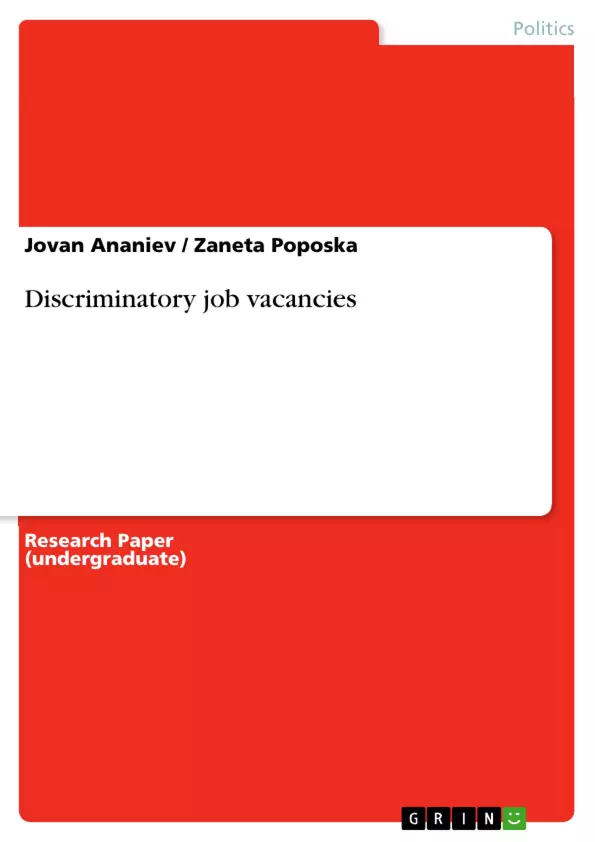This Research Report contains results from the research of discriminatory job vacancies. It was carried out over a sample of 988 job vacancies, advertised in four daily newspapers and a Web portal in the period from 15th April to 15th September 2013. Data were transformed into codes, which were analyzed in a statistical software later on, and quantitative data were obtained as a final product. Job vacancies were subject of the analysis.
This research is first of its kind, providing for several benefits. First, it is a systematized monitoring of a phenomenon for a period of five months and is abundant of data, which can be corrected and can provide for the actual state-of-play as regards the occurrence of discriminatory job vacancies. Hence, it enables the experts to obtain comprehensive observations, helps the Commission for Protection against Discrimination to alert and give recommendations, and assists the policy creators to undertake measures aimed at tackling and resolving the actual situation. Second, it contributes to the science that studies human rights and the labour and labour relations so as to gaining knowledge on the subject of the research, together with all its specifics. Third, the research also contributes from a methodological point of view, since it can serve as a model to translate qualitative into quantitative data and provide for their further statistical and descriptive interpretation.
The text gives general overview of the national legislation in the area of anti-discrimination and labour relations and describes the methodology, the sample being researched, the level of discrimination, the forms of discrimination, the bases for discrimination, and delivers conclusions and recommendations.
Inhaltsverzeichnis (Table of Contents)
- INTRODUCTION
- OVERVIEW OF THE NATIONAL LEGISLATION
- Law on Prevention and Protection against Discrimination
- Law on Labor Relations
- METHODOLOGICAL FRAMEWORK
- RESEARCH RESULTS
- RESEARCH SAMPLE
- DISCRIMINATORY AND NON-DISCRIMINATORY JOB VACANCIES IN THE PRINTED MEDIA
- FORMS OF DISCRIMINATION
- BASES FOR DISCRIMINATION
- MULTIPLE DISCRIMINATION IN JOB VACANCIES
- CONCLUSIONS AND RECOMMENDATIONS
Zielsetzung und Themenschwerpunkte (Objectives and Key Themes)
This research report focuses on the prevalence of discriminatory job vacancies in Macedonia, analyzing data collected from print media and web portals. The report aims to provide a comprehensive overview of the phenomenon, identify the forms and bases of discrimination, and contribute to the development of policies and measures aimed at combating this issue. Key themes explored in the report include:- Discriminatory job vacancies in the Macedonian context
- Forms of discrimination in employment
- Bases for discrimination in job vacancies
- Impact of discrimination on employment opportunities
- Recommendations for addressing discriminatory practices in the labor market
Zusammenfassung der Kapitel (Chapter Summaries)
- INTRODUCTION: This chapter provides an overview of the research, outlining its scope, methodology, and significance. It highlights the need for this research, given the lack of systematic monitoring of discriminatory practices in the Macedonian labor market.
- OVERVIEW OF THE NATIONAL LEGISLATION: This chapter examines the relevant national legislation in Macedonia concerning the prevention and protection against discrimination, particularly in the context of labor relations. It analyzes the provisions of the Law on Prevention and Protection against Discrimination (LPPD) and the Law on Labor Relations, highlighting the legal framework for addressing discriminatory practices in the workplace.
- METHODOLOGICAL FRAMEWORK: This chapter delves into the methodology employed in the research, detailing the criteria for selecting the sample of job vacancies, the coding protocol used for data analysis, and the software used to analyze the quantitative data. It provides a clear and detailed explanation of the research methodology, ensuring transparency and replicability.
- RESEARCH RESULTS: RESEARCH SAMPLE: This chapter presents the characteristics of the research sample, outlining the number of job vacancies analyzed, the sources of data, and the time period covered by the study. It provides the reader with a clear understanding of the scope and limitations of the sample.
- RESEARCH RESULTS: DISCRIMINATORY AND NON-DISCRIMINATORY JOB VACANCIES IN THE PRINTED MEDIA: This chapter analyzes the prevalence of discriminatory and non-discriminatory job vacancies in the printed media, presenting data on the frequency and types of discriminatory language used in job advertisements. It examines specific examples of discriminatory job vacancies to illustrate the findings.
- RESEARCH RESULTS: FORMS OF DISCRIMINATION: This chapter delves into the various forms of discrimination identified in the research, examining the specific types of discriminatory practices employed in job vacancies. It provides a detailed analysis of the different forms of discrimination, including direct and indirect discrimination.
- RESEARCH RESULTS: BASES FOR DISCRIMINATION: This chapter explores the grounds upon which discrimination is based in the job vacancies analyzed. It examines the different factors used to discriminate against job applicants, such as gender, ethnicity, religion, and disability.
- RESEARCH RESULTS: MULTIPLE DISCRIMINATION IN JOB VACANCIES: This chapter investigates instances of multiple discrimination in job vacancies, where individuals are discriminated against on the basis of several grounds simultaneously. It analyzes the intersectional nature of discrimination and its impact on marginalized groups.
Schlüsselwörter (Keywords)
This research report focuses on discriminatory job vacancies in the Macedonian context, examining the prevalence, forms, and bases of discrimination in the labor market. Key terms and concepts include: discrimination, employment, job vacancies, labor relations, national legislation, quantitative analysis, and anti-discrimination measures.- Citar trabajo
- Jovan Ananiev (Autor), Zaneta Poposka (Autor), 2013, Discriminatory job vacancies, Múnich, GRIN Verlag, https://www.grin.com/document/286600



